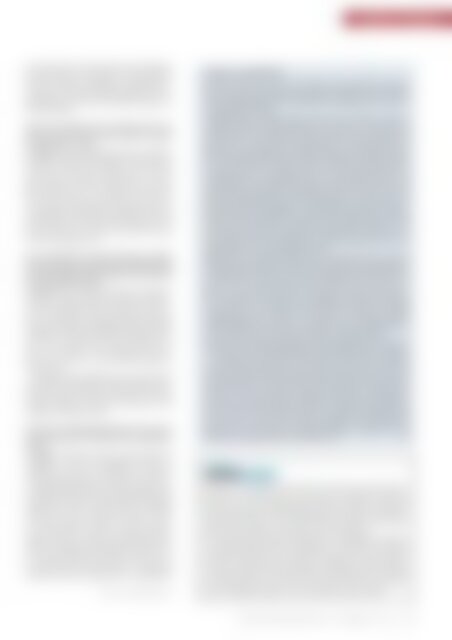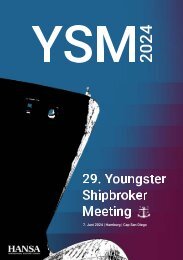HANSA 10-2017
Fährschifffahrt | Brexit | HIPER | Schifffahrt der Zukunft | Börsenbericht | US Ports & Hurricanes | Abwasser | Häfen Niedersachsen | HVAC | Job-Börse | Offshore-Marktkompass
Fährschifffahrt | Brexit | HIPER | Schifffahrt der Zukunft | Börsenbericht | US Ports & Hurricanes | Abwasser | Häfen Niedersachsen | HVAC | Job-Börse | Offshore-Marktkompass
Sie wollen auch ein ePaper? Erhöhen Sie die Reichweite Ihrer Titel.
YUMPU macht aus Druck-PDFs automatisch weboptimierte ePaper, die Google liebt.
Schifffahrt | Shipping<br />
ble to implement. Along with important Flag States<br />
and other industry associations we developed the<br />
technical evidence to underpin a change to the requirements.<br />
The result: IMO changed the EEDI requirements<br />
by 20% and introduced an upper size<br />
DWT threshold.<br />
What do you think will be used primarily in the<br />
future of the ferry fleet: LNG or battery systems?<br />
Or other power sources?<br />
Corrigan: At our upcoming conference in Split in<br />
October, members and attendees will learn what<br />
the future of the ferry industry may look like.<br />
They’ll hear more about electrification – the next<br />
game changer in the ferry industry. They will also<br />
learn about LNG as a transition fuel away from<br />
more carbon-intensive forms of energy, to more environmentally-<br />
friendly sources. Batteries are seen<br />
by the industry to be the wave of the future, once its<br />
been proven they can operate successfully on large<br />
vessels with longer routes.<br />
How could ship sizes and ship designs develope<br />
in the coming years? Some experts argue that the<br />
ferry fleet is quite old and therefore the demand<br />
of new buildings will grow.<br />
Corrigan: We are pleased that the overall ferry<br />
market is continuing to grow, and believes that given<br />
vehicle congestion on land, this growth will continue.<br />
Couple this with owners having more certainty<br />
with regards to Damage Stability and EEDI<br />
regulations, and there should be strong growth in<br />
new vessel construction for RoRo vessels. Also,<br />
there are a number of new passenger-only ferry<br />
business start-ups as a result of the growing tourism<br />
economy.<br />
The future looks bright for ferry operators and<br />
the industry, and Interferry looks forward to playing<br />
a role in advocating for the industry to become<br />
stronger together, and share best practices with<br />
members around the world.<br />
What do you think should be taken into account<br />
more intensively by the political and regulatory<br />
bodies?<br />
Corrigan: Interferry has been intervening with<br />
regulators to ensure that regulations under development<br />
take into consideration all aspects<br />
of the shipping industry in general, and the ferry<br />
industry specifically. We are fortunate to have<br />
consultative status at the International Maritime<br />
Organization (IMO). Compared to the shipping<br />
industry, the size of the ferry industry is small.<br />
As a result, being a member of a trade association<br />
like Interferry makes the industry stronger<br />
together than any member could possibly be on<br />
its own. In Europe, for example, only 3% of public<br />
funding is allocated to the ferry industry versus<br />
other modes of transportation. A strong and<br />
unified voice has the opportunity to change this.<br />
Interview: Michael Meyer<br />
Interferry and IMO <strong>2017</strong><br />
Recently, Interferry worked with the IMO on a range of files. However,<br />
three files particularly impact on members. Besides the topic of EEDI<br />
these are Damage Stability and Ballast Water Management, as Interferry<br />
published in summer.<br />
Damage Stability: Damage stability refers to a ferry’s ability to endure a<br />
collision and survive long enough for the ship to be evacuated in an<br />
orderly fashion. From Interferry’s point of view, the research has focused<br />
much more on requiring the »unsinkable ship«, than preventing a collision<br />
from occurring in the first place. After years of debate, in June<br />
<strong>2017</strong>, the IMO Maritime Safety Committee adopted new damage stability<br />
requirements for passenger ships. »The new regulations may be<br />
challenging to meet, especially for ferries with long lower holds«, the<br />
association said. It teamed up with Japan and other countries to ensure<br />
that the technical guidelines could indeed be achieved, especially for the<br />
smaller end of the ferry segment. »We managed to overturn a previously<br />
agreed level of »unsinkability« to end up with requirements we believe<br />
to be reasonable for ships carrying fewer than 1,000 passengers. For the<br />
larger ships, and in the aftermath of the sinking of the cruise ship »Costa<br />
Concordia«, the EU was adamant in introducing regulations that more<br />
steel/subdivision is required going forward.<br />
Ballast Water: Interferry believed that the spread of invasive species<br />
should be prevented, but the issue is intercontinental rather than regional.<br />
»Requesting a 20nm ferry to kill off all organisms in the ballast water<br />
it lifts in Port A, and discharges in Port B, didn’t make sense for our industry«,<br />
it was said. If a ferry always operates in the same water, Interferry<br />
argued that it should not be accountable for the spread of foreign<br />
species. Interferry was »pleased« that the IMO resolved this issue through<br />
a staggering process related to the ships’ dry docking schedule.<br />
MEPC71 added two more years of compliance time, extending the previous<br />
September <strong>2017</strong> enforcement timeline to September 2019.<br />
Interferry successfully participated in and negotiated three situations<br />
our members would find challenging related to Ballast Water Exchange.<br />
According to the association, since spread of invasive species is predominantly<br />
an intercontinental issue, provisions are in place for short sea ship<br />
to be exempted from the requirements to fit treatment systems. »These exemptions,<br />
however, are onerous and call for the operator to conduct biological<br />
surveys and risk assessments. Together with Denmark and Singapore,<br />
Interferry successfully argued for the IMO to introduce an alternative approach,<br />
where it is not a specific ship that is exempted, but a geographical<br />
area, such as the common waters between Singapore and Indonesia. The<br />
legal provision is now in place, waiting for operators to engage with their<br />
Port States to designate these »Same Risk Areas.«<br />
M<br />
Interferry was originally formed in the USA in1976 as the International<br />
Marine Transit Association. Since then it has changed its name and<br />
has become a association representing the ferry industry world-wide.<br />
There are currently over 200 members from 35 countries. The membership<br />
includes all types of ferry operations: RoPax, RoRo, Cruise Ferries,<br />
Fast Ferries, Passenger-only Ferries, big and small ferries.<br />
The membership also includes suppliers such as: shipbuilders and designers,<br />
equipment manufacturers and suppliers, naval architects and marine<br />
engineers, ship brokers and consultants, classification societies, publishers<br />
as well as specialists in information technology, finance, insurance,<br />
crewing, training, etc. The association sees its primary roles »to facilitate<br />
networking and communications within the ferry industry and to represent<br />
it on regulatory matters.« It has consultative status at IMO.<br />
<strong>HANSA</strong> International Maritime Journal – 154. Jahrgang – <strong>2017</strong> – Nr. <strong>10</strong> 37


















